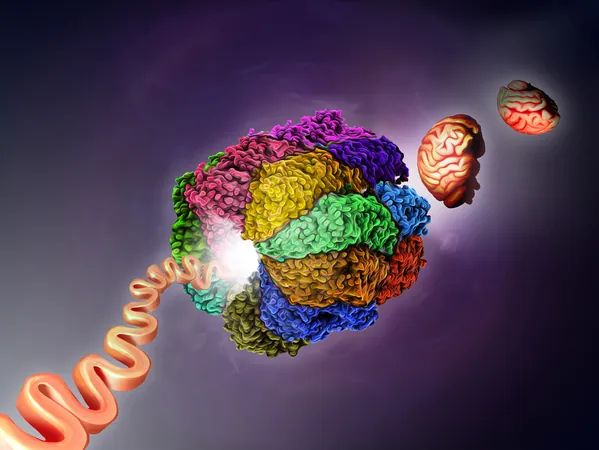
Groundbreaking Study Reveals Shocking Link Between Rare Brain Disorders in Children and Protein Misfolding
2024-11-18
Author: Siti
Introduction
In a stunning development for pediatric neuroscience, a team of researchers has uncovered a direct association between enigmatic brain malformations in children and mutations affecting a vital protein folding complex known as TRiC. This revelation, published on October 31 in the prestigious journal *Science*, sheds new light on the complexities of brain development and neurological disorders.
Background on TRiC
The story begins with Judith Frydman, PhD, who, back in 1992, identified TRiC, a critical chaperone that ensures proteins are folded correctly within our cells. Proper protein folding is vital; misfolded proteins can lead to various diseases, including several types of cancer and neurodegenerative disorders like Alzheimer’s. TRiC plays a significant role, as approximately 10% of all human proteins require its assistance to reach their correct 3D configurations.
Collaboration and Discovery
Fast forward three decades to present day, Frydman’s serendipitous meeting with Dr. Ingo Kurth, a pediatrician at RWTH Aachen University, prompted further inquiry into a perplexing case. A child suffering from intellectual disabilities, seizures, and significant brain malformations was found to have a mutation in a component gene of TRiC, specifically CCT3. This raised an important question: could the TRiC mutation be the underlying cause of the child’s severe symptoms?
As researchers delved deeper, they established a collaboration that included experts from Washington University School of Medicine in St. Louis. They sought to understand the implications of the mutation in various model organisms, including roundworms, yeast, and zebrafish. Their investigations revealed a remarkable pattern: 21 additional cases were identified across a genetic database, where children presented with similar neurodevelopmental challenges linked to mutations in various components of the TRiC complex.
Emergence of TRiCopathies
From this ground-breaking research, the team proposed a new category of neurological disorders termed "TRiCopathies." Their striking findings not only highlight the crucial role of TRiC in brain development but also challenge the previously held notion that mutations in this protein-folding complex inherently led to lethality. Interestingly, patients commonly possessed one healthy copy of the TRiC complex gene alongside the mutated one, indicating potential pathways for further therapeutic exploration.
Experimental Findings
Frydman emphasized the need for a revised understanding of chaperones like TRiC, which seem to play an outsized role in neurological health: “This opens a whole new way of thinking about the role of chaperones in brain development."
The researchers' experiments yielded surprising results—while some mutations resulted in cellular death within yeast, others did not, suggesting a spectrum of severity tied to the mutation's location within the TRiC complex. Models in zebrafish and roundworms indicated that while the single mutated version of the CCT3 gene was detrimental, embryos with one normal gene retained survival, albeit with developmental delays and defects.
Mechanisms and Future Directions
A particularly intriguing aspect of the study is the researchers’ identification of potential culprits for the neurological issues stemming from the TRiC mutations. They believe that the misfolding of essential structural proteins, such as actin and tubulin—which govern cell movement and stability—could be significant contributors. Defects in these proteins were visually confirmed in mutant roundworms, pointing toward the overarching implications of protein misfolding in neural pathways.
Looking forward, Frydman and her team intend to explore the specific mechanisms by which these mutations disrupt the function of TRiC, utilizing innovative techniques to analyze how misfolded proteins affect neuronal cells. They aim to derive neurons from affected patients' cells and develop brain organoids, which will provide critical insights into the direct impact of these mutations on human brain function.
Conclusion
This research highlights the vital intersection of basic science and clinical applications, promising new avenues for understanding and potentially treating neurological disorders rooted in protein misfolding. As Frydman notes, "This work is a nice example of basic science connecting with medicine," paving the way for future breakthroughs in treating these rare, complex conditions.


 Brasil (PT)
Brasil (PT)
 Canada (EN)
Canada (EN)
 Chile (ES)
Chile (ES)
 España (ES)
España (ES)
 France (FR)
France (FR)
 Hong Kong (EN)
Hong Kong (EN)
 Italia (IT)
Italia (IT)
 日本 (JA)
日本 (JA)
 Magyarország (HU)
Magyarország (HU)
 Norge (NO)
Norge (NO)
 Polska (PL)
Polska (PL)
 Schweiz (DE)
Schweiz (DE)
 Singapore (EN)
Singapore (EN)
 Sverige (SV)
Sverige (SV)
 Suomi (FI)
Suomi (FI)
 Türkiye (TR)
Türkiye (TR)